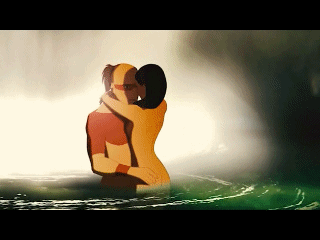originally posted at https://canmom.tumblr.com/post/660600...
It’s sure been a while since we left Japan, hasn’t it? Everyone always jokes that left to just me, Animation Night soon becomes Anime Night, but well… guess they’re right ><
Tonight, though, I want to return to the tradition of shining a spotlight on a particular country’s animated films! In this case, that country is Brazil.
(here’s a modern Brazilian tribute to the history of Brazilian animation from an Annecy a few years back.)
Me n Elaine had been planning this one for a while, because a couple of Brazilian films showed up in the Annecy award listings, but it was frustratingly hard to get a hold of them. I’m not sure what I was missing because I have now been able to find a fairly old torrent source for the second movie we wanted to show, Rio 2096: A Story of Love and Fury, which I couldn’t at the time. But in any case, we’re here now…
With English-language sources, it’s kind of harder to tell the story of Brazilian animation than, say, the history of anime or donghua. But there is at least a Wikipedia article that lists some of the major landmarks, and I’ve found a wonderful article by Milton Knight that digs into some of the earliest films.
Brazilian animation got going early in the 20th century, inspired by the animated vignettes shown at the end of newsreels. The first ‘autonomous’ Brazilian animated film was Kaiser (1917) by Álvaro Marins aka Seth, poking fun at Kaiser Wilhelm II a few months before Brazil joined WWI against him. Unfortunately this film has been completely lost except for one frame. You can see a modern reconstruction (and continuation) by eight Brazilian animators of different techniques here:
Seth’s studio were pretty much the only game in town for the first decade or so of Brazilian animation, working a lot in advertising.
Among his collaborators were João Stamato and Luiz Seel, whose Macaco fêio, macaco bônito (Ugly Monkey, Pretty Monkey) is the oldest film to survive. The clip I saw there shows a lot of influence from early American animation like the Fleischers and Disney (with explicit allusions to Mickey Mouse, Popeye and Felix the Cat, though only Mickey appears on screen): there’s the same reliance on walk cycles and very flat perspective, the same world of inanimate objects that come alive with faces to make short looping dances, and unfortunately the same minstrel caricatures. I’ve only been able to find clips: this one is short but has the best quality, while this one has slightly more footage if you can see it through the noise :p
Seel also made another interesting early film that leaned hard on art-deco aesthetics. Milton Knight gave a good description:
Opening with the announcement“Dedicated to the Viennese”, which is followed by the title “The Miracle of The Radio as Reported from The New York Radio Exhibition”, Seel reveals a flapper’s morning antics modernized through the Miracles of Radio Control and Television.
This short is in certain ways OUT OF THE INKWELL with an erotic twist. Seel’s hand draws a flapper girl, posed by his wife, actress Olivette Thomas, who is given a screen credit as “My Model”. She parades through elegant (find another adjective!) states of undress, her nudity shielded by the artist’s hand at the most provocative intervals. Drawings are the height of Art Deco modernity.
(so yeah animated porn is pretty much as old as animation itself. but more on that next week.)
By 1930, Seel was experimenting with rotoscopy in Frivolitá, which is basically the same idea: a flapper gets up in the morning and is harassed by a small army of screaming cats. This time the figure has more realistic proportions and there are a lot more experiments with camera shots.
Luiz Sa shows up as a contemporary of these guys; a comic/magazine cartoonist who turned to animation in 1938-39. As Knight describes it, his early drawings are full of awful racial caricatures. (I can’t discuss in depth, but the impression I have is that Brazilian racism is not identical to American racism, but shares a lot of common features - and of course, both countries were built on slavery.) His turn to animation took the form of a series called The Adventures of Virgulino, an anthropomorphic cat, and seem to have been popular.
Sa’s story comes to a rather sorry end, in any case; when Walt Disney came to visit Brazil, hoping to promote “cooperation between the three Americas”. This was, in the context of WWII geopolitics, part of a broad effort by the US to win around South and Central American countries which might sympathise with the nazis. To this end, the government funded Disney (who at the time was facing major labour struggles) to work on films like Saludos Amigos (1942) and The Three Caballeros (1944). As part of the project, Disney went on multiple tours of South America; in 1939 he went to Brazil to warm reception. Luiz Sa hoped to show his films to Disney, but the Brazilian government forbade him: in Knight’s words,
Sa’s rudimentary efforts were okay enough to be shown on home territory, but that they should represent the nation’s skill to Walt Disney was out of the question
You can imagine how discouraging that was, and Sa sold off all of his films to an advertising company and returned to newspapers. The films were recut, and some clips survive:
Brazil’s first feature-length animated film arrived when brothers Anélio and Mario Latini Filho got into animation in the 40s; Anélio launched an obsessive six year project to singlehandedly animate a film based on Native folklore, interpreted by screenwriter Joaquim Ribeiro. His brother helped with photography, and composed an original samba; otherwise the film is scored with classical music. The Sinfonia Amazônica project was finished in 1953, but tragically couldn’t turn a profit. The whole thing’s available on Youtube, albeit without subtitles, and includes a short making-of at the beginning:
The film’s pretty impossible to follow if you don’t understand the Portugese narration, but skip to about 49:43 for the impressive samba sequence with some very lively dancing animation.
In the 50s and 60s, it seems a lot of Brazilian animation took a turn towards the experimental, with people like Roberto Miller returning from a stay with Norm McLaren to create short films such as *ctrl-v* Boogie Woogie (1959), Desenho abstrato (Abstract Drawing, 1960), O átomo brincalhão (The Playful Atom, 1968) and Fotograma Abstrato (Abstract Frame, 1985). Unfortunately the only example I can find of his work is recorded in terrible quality and doesn’t name the film itself. His contemporaries included Rubens Francisco Lucchetti and Bassano Vaccarini, founders of the short-lived Centro Experimental de Cinema.
The 70s saw animated film start to grow a bigger presence, with more studios opening, and a lot greater use in advertising; unfortunately this is where my source becomes much less detailed. All I can say is that the films of this era included Presente de Natal (1971) and Piconzé (1973), both of which were full colour feature films; the latter was directed by a Japanese immigrant Ypê Nakashima.
The next big landmark comes in 1996, with what is apparently the second ever full-CG feature film, Cassiopeia, produced over largely the same period as Toy Story. From the sounds of things, it’s a straightforward kids’ sci-fi film. The team behind was very small, only a handful of CG artists and traditional animators; during production some of their computers were stolen forcing reanimation of parts of the film. So it’s worth some respect for like, pulling off a CG film on shoestrings.
And that brings us to the 2000s, where things really took off in a much bigger way. In part that involved an explosion of childrens’ animation, but internationally, the two big films are Boy and the World and Rio 2096: A Story of Love and Fury, both winners of Annecy in their respective years - and both the films which we’re watching tonight ;)

Boy and the World (O Menino e o Mundo) adopts a variety of quite abstract, childrens’ book styles; but the film actually seems to be more of an anti-capitalist parable, told largely without dialogue (they use the old ‘play it backwards’ trick to create nonsense dialogue in the few scenes that have it). It shows a boy on a kind of magical journey which leads him to observe different stages of cotton production, in each case witnessing abuses of workers, gradual automation, and ecological catastrophe, but also the seed of rebellion. Which sounds quite arthousecore, no wonder it won Annecy lol, but I’m looking forward to seeing the different ways they present it.
Rio 2096 seems like a very striking one, adopting a much more realistic aesthetic somewhere between anime and early dreamworks (the prince of egypt etc.). Its sweeping narrative cuts through Brazil’s history in a series of vignettes, and imagines its future, and the picture it paints does not sound pretty: the initial arrival of Portugese explorers in 1566, slavery in 1828, the height of the rule of the fascist military dictatorship in 1968, and finally a future war over water in 2096. So that’s some serious social trauma to be working through there. The throughline is an immortal man who awaits the resurrection of his lover Janaína who turned into a bird.

Neither of these films sound exactly shy about their politics lol, which is hopefully a really good sign. And having a quick look through Rio, it looks startlingly impressive visually, reminiscent of also-overlooked Korean films like Wonderful Days. Tragically it’s extremely hard to get a hold of this film here: I can import an Italian bluray, or rely on a barely-seeded torrent. If it proves to be as good as it looks, I’d love for it to get more attention.
In the near future there’s also going to be another major release: the Chilean film Nahuel and the Magic Book, which does its best to take on a Ghibli-esque style, also invlved a lot of work by Brazilian animators. It looks like it did the film festival circuit last year, and it’s set for a wider release at some vague point later this year, so look forward to that!
Right now, though… if you’d like to watch some Brazilian animated films, Animation Night 68 will be starting around 7pm UK time (about an hour!) at twitch.tv/canmom. Our main features are the two mentioned above, but I’ll also put in some of the shorter things I’ve discussed up there, and maybe it’s worth showing Disney’s tribute to Brazil in Saludos Amigos since it’s part of the story we’ve told…
Comments